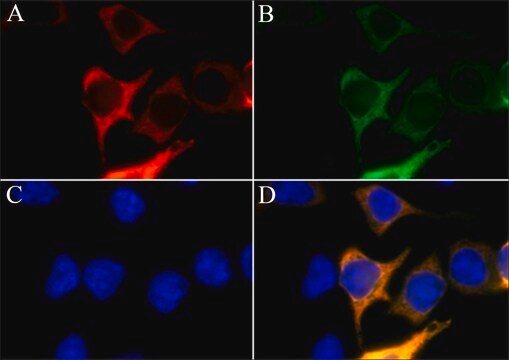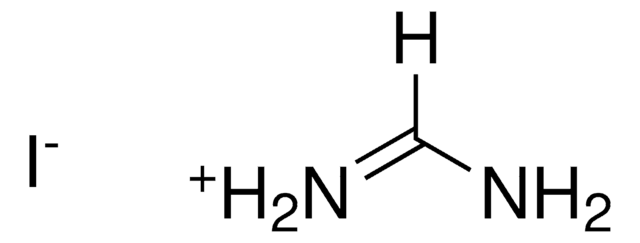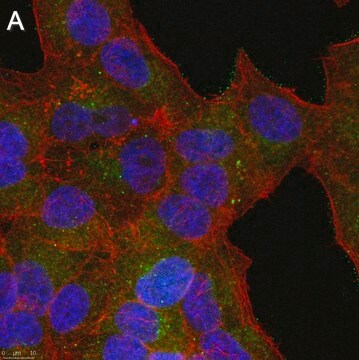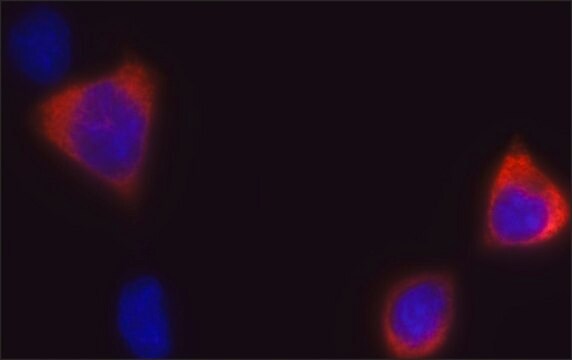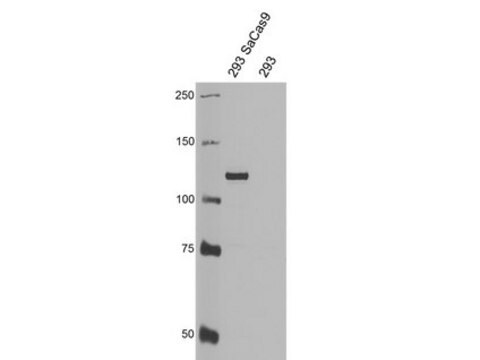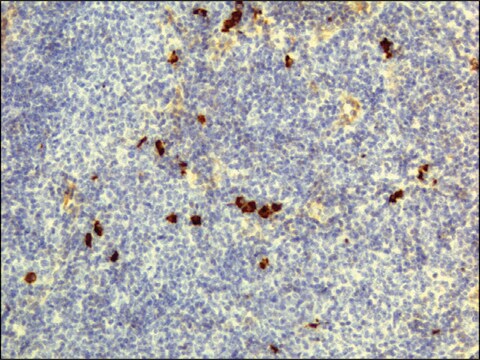Key Documents
SAB4200777
Anti-LbCas12a (Cpf1) antibody, Mouse monoclonal
clone LbCpf1, purified from hybridoma cell culture
Synonim(y):
Anti-CRISPR-associated endonuclease AsCas12a from Lachnospiraceae bacterium ND2006, Anti-LbCpf1 antibody, Mouse monoclonal
About This Item
Polecane produkty
pochodzenie biologiczne
mouse
Poziom jakości
forma przeciwciała
purified from hybridoma cell culture
rodzaj przeciwciała
primary antibodies
klon
LbCpf1, monoclonal
Postać
buffered aqueous solution
masa cząsteczkowa
~135 kDa
stężenie
~1.0 mg/mL
metody
immunoblotting: 0.6-1.2 μg/mL using human HEK-293T cells over-expressing LbCpf1 protein
immunofluorescence: 0.25-0.5 μg/mL using human HEK-293T cells over-expressing LbCpf1 protein
immunoprecipitation (IP): 1-2.5 μg/test using lysate of human HEK-293T cells over-expressing LbCpf1 protein
izotyp
IgG1
numer dostępu UniProt
Warunki transportu
dry ice
temp. przechowywania
−20°C
docelowa modyfikacja potranslacyjna
unmodified
Opis ogólny
Cpf1 (CRISPR from Prevotella and Francisella 1) belongs to class 2 type V CRISPR-Cas endonuclease system. Cpf1 comprise several differences from Cas9 protein including cleavage with 5′ overhangs, a shorter guide RNA and a longer distance between the seed sequence and cleavage site.
LbCpf1, Cpf1 from Lachnospiraceae bacterium ND2006, was examined together with 15 members of Cpf1 nuclease family and proved to mediate efficient genome editing in HEK293FT cells with improved results compared to SpCas9.5 According to thr crystal structure, LbCpf1 has a triangle-shaped architecture with a large positively charged channel at the centre.7 The crRNA binding was shown to induce the pronounced structural rearrangements of LbCpf1, leading to formation of a substrate-binding conformation of LbCpf1. Over-expressed in plant cells, LbCpf1 demonstrated more than 10-fold transcriptional repression of the target gene.
Monoclonal anti-LbCpf1 antibody can provide a useful tool for genome editing research, such as detecting and monitoring LbCpf1 positively transfected cells.
Immunogen
Zastosowanie
Postać fizyczna
Przechowywanie i stabilność
Inne uwagi
In order to obtain best results in different techniques and preparations we recommend determining optimal working concentration by titration test.
Nie możesz znaleźć właściwego produktu?
Wypróbuj nasz Narzędzie selektora produktów.
Kod klasy składowania
12 - Non Combustible Liquids
Klasa zagrożenia wodnego (WGK)
nwg
Temperatura zapłonu (°F)
Not applicable
Temperatura zapłonu (°C)
Not applicable
Wykazy regulacyjne
Wykazy regulacyjne dotyczą głównie produktów chemicznych. Można w nich podawać ograniczoną liczbę informacji na temat produktów niechemicznych. Brak wpisu oznacza, że żaden ze składników nie znajduje się w wykazie. Użytkownik odpowiada za zagwarantowanie bezpiecznego i zgodnego z prawem stosowania produktu.
EU REACH Annex XVII (Restriction List)
Certyfikaty analizy (CoA)
Poszukaj Certyfikaty analizy (CoA), wpisując numer partii/serii produktów. Numery serii i partii można znaleźć na etykiecie produktu po słowach „seria” lub „partia”.
Masz już ten produkt?
Dokumenty związane z niedawno zakupionymi produktami zostały zamieszczone w Bibliotece dokumentów.
Nasz zespół naukowców ma doświadczenie we wszystkich obszarach badań, w tym w naukach przyrodniczych, materiałoznawstwie, syntezie chemicznej, chromatografii, analityce i wielu innych dziedzinach.
Skontaktuj się z zespołem ds. pomocy technicznej